We all have friends who get let down in their business endeavors. If we’re unlucky, it might be us instead. We open a business, and all our family and friends encourage it. They even show up on opening day. But then, two weeks later, there’s no one inside the store.
The hype and encouragement can blind the business owner until reality sets in: Customers aren’t engaged with the product and store.
Customer engagement proves that your app experience is working. Your platform has value, so users are willing to invest in your SaaS and continue as paying customers.
Engagement scores also serve as a litmus test to predict user behavior shifts.
If the score goes up, that’s great. You can figure out what’s contributing to the increase and double down. If the score decreases, it’s a sign that you’re in trouble. Customers don’t see your value, or they are getting frustrated.
But before you attend a feel-good seminar that shouts “Let’s raise the score!” and then asks you to sign up for the fast-track program (which costs twice as much), we’ll save you time and money.
You can’t force engagement.
And if you’re trying to catch up, you’re starting too late.
We can fix that, but don’t let it happen again every year—like that guy who keeps saying he’ll stop inviting you to play FarmVille but sends you an invite the next day.
If you want a winning engagement score, your app should provide a top-notch, familiar, intuitive experience on day one. The app should also offer a personalized, customizable user journey.
What is an engagement score for SaaS?
An engagement score illuminates the current value customers receive from your product by measuring user interactions with an app.
The metric helps leaders understand how actively and effectively users use the platform.
A SaaS engagement score often considers usage frequency, depth of usage, feature adoptions, user satisfaction, customer retention rates, and other relevant data points.
Why is your product engagement score so important?
SaaS companies should leverage customer engagement scores to create sustainable product growth. They can delve deeper into what engagement methods mean for the company instead of attempting to improve scores for the sake of improving scores.
In other words, brands can focus on intentional growth that produces the most ROI. Companies should identify the types of engagement that move the needle and how to improve those specific realities.
One top reason for a product engagement score is to detect at-risk users that may churn.
By analyzing how often your customers interact with your app and studying behavioral patterns over time, you can spot problem areas and improve the platform experience.
An engagement score also helps you find your super users and study behavior to improve the product based on what’s working for them. Plus, you can invite those users to promote the platform by becoming ambassadors and spreading the word. You can start a loyalty program and gamify referrals with rewards.
Additionally, engagement scores can identify customers that you could upsell or cross-sell. If a certain customer group is extra happy with your solution, you can promote a subscription package with more features. You can also use customer feedback and usage data to develop a new feature or add-on for more value.
Ultimately, a better engagement score means better long-term health for your company.
The more customers engage, the higher your customer retention and satisfaction rate will be. The positive and engaged user experience helps scale and grow your company for the future.
Time for pen and paper: How to calculate an engagement score

Is there a formula? Yes and no.
Your company needs to define what goes into your score first and then build a formula to calculate the score per desired metric. However, companies can use a template to construct the calculation.
Businesses can first define events that show user engagement.
For example, a particular feature usage can be an event. If you have an in-app forum or community, and a user interacts, that can be an event. When the user logs in, that can count as another event. Define which moments are notable and represent engagement the best.
Then you can create a weighted framework.
You can rate each event based on a level of importance. For example, you can use a scale of 1 to 5 (or up to 10). Once you rate each event, you’re ready for the next step.
The calculation formula would then be:
Customer engagement score = (Weighted value of event #1 ✕ total occurrences) + (Weighted value of event #2 ✕ total occurrences) + (Weighted value of event #3 ✕ total occurrences) + (Weighted value of event #4 ✕ total occurrences)...
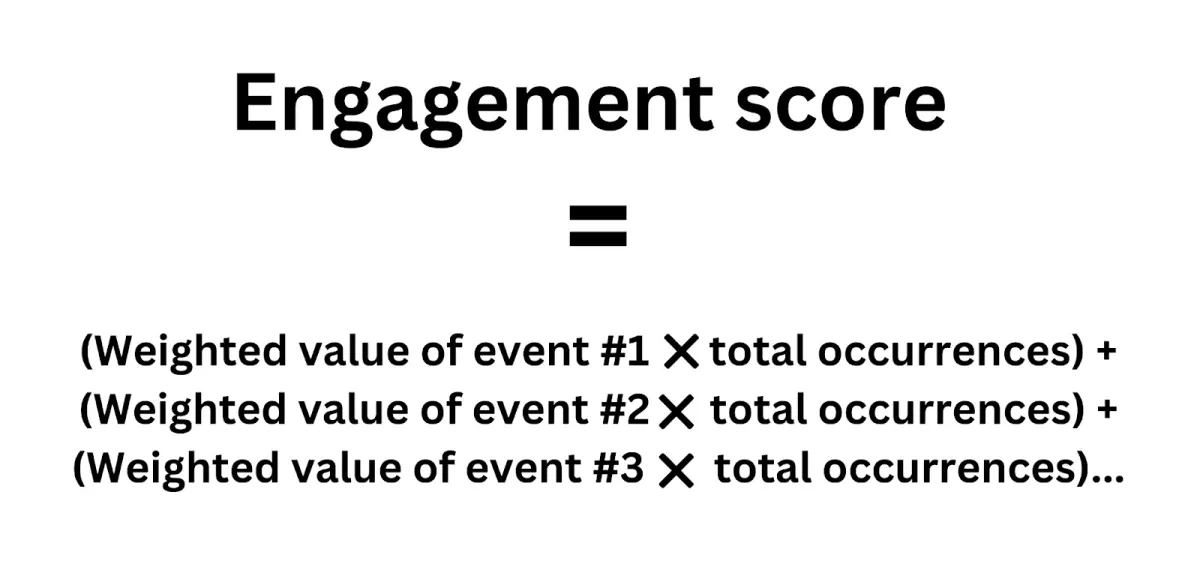
As you improve your score, you can create a percentage system to measure your customer engagement score compared to the last period.
Critical metrics for customer engagement
There are many metrics you can include in your engagement score. Popular metrics that go into user engagement include:
- Customer retention rate
- User churn rate
- Net promoter score
- Product adoption rate
- Customer activation rate
- Feature adoption rate
- Feature usage rate
The key is to identify which scores are the most important for your overall engagement score and to experiment until you have the ideal baseline for engagement metrics.
Companies can test their own engagement scoring formula by using the data they already have. Add and remove metrics based on super, churned, and average users, and see which score (made up of your mix of metrics) may best represent and measure engagement.
Yeah, but then what? Deciding what “good” engagement is
Good engagement looks different per industry and product category.
It’s not like you’re measuring employee engagement scores for your team, where they have a vested interest in your vision. These are customers—and active users have minds of their own. They aren’t invested in your app until you can prove it and sustain it.
James Evans, CEO of Command AI, illustrates the nuance when companies define what “measure customer engagement score” means: “A B2B HR tool is going to get way less engagement than TikTok.” That analogy perfectly explains the uniqueness of engagement—each app is unique and has different goals and standards for user interactions.
As a leader for your SaaS, it’s critical that you define what “good” looks like to measure customer engagement.
It will involve studying your super users as a benchmark for the best-case scenario. Then, you analyze other segments based on usage. Finally, you identify your churned customers and get an engagement score average so you know what a poor customer engagement looks like before a user leaves forever.
Once you’ve built your benchmark, you can grow your app.
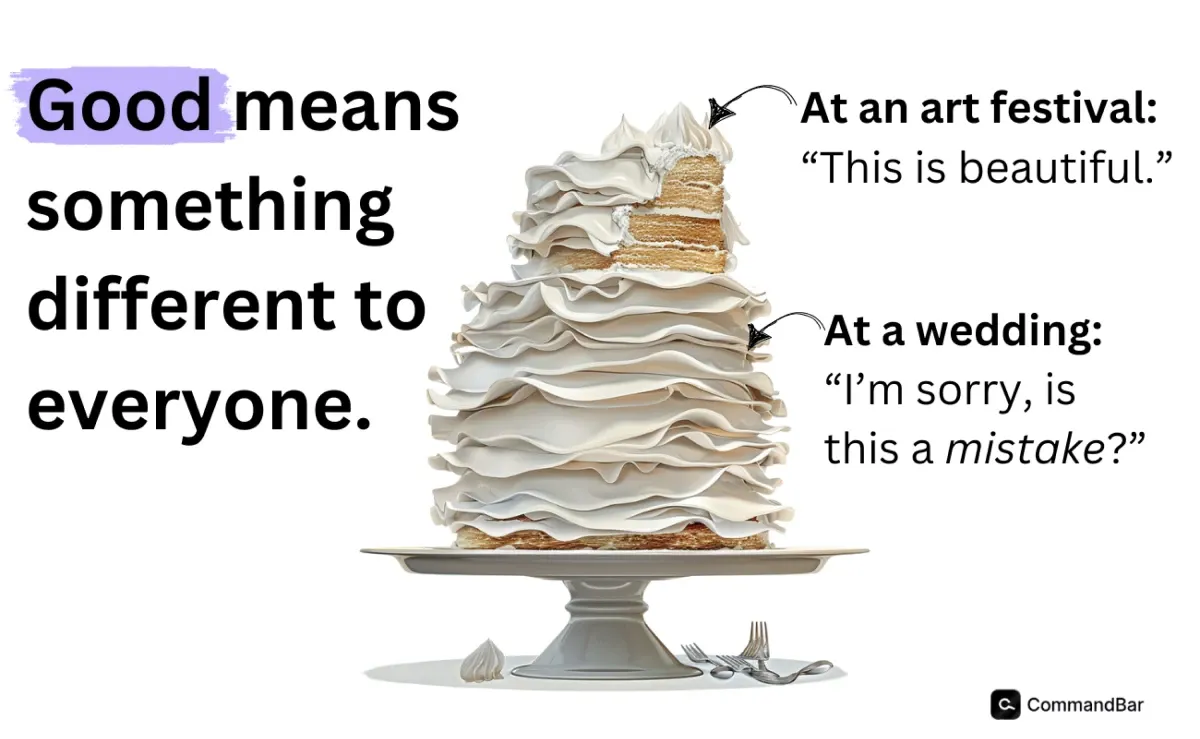
The way you construct your score doesn’t need to be the same way everyone else does it. Your score will consist of unique shades and colors.
Daivat Dholakia, VP of operations at Essenvia, a medical technology regulatory submission company, shares how his company likes to build a customer engagement score:
“We track how frequently users engage with key features of our product as a way to gauge engagement. We also monitor the number of support requests to identify areas of improvement.”
This traditional approach gives leaders like Dholakia a baseline view of their users. One key element of Essenvia’s approach is feedback, an essential but sometimes overlooked ingredient for action.
Dylan J. Cleppe, CEO of OneStop Northwest, a web solution company, shares his experience with a “good” score and taking action with detected issues:
“A ‘good’ engagement score in our context has consistently been about how deeply and frequently customers interact with our solutions … For example, a substantial increase in engagement for us was identified when customers began regularly using the detailed analytics features we offer … users not only found these features valuable but were integrating them deeply into their operational workflows.”
When Cleppe’s team spotted an underutilized feature, they analyzed user feedback and session data and discovered that the onboarding process was too complicated. After simplifying the process and introducing guided tours, customer engagement rose 30% in the next quarter.
Cleppe’s experiences highlight the crucial reason we need an engagement score in the first place: We can assess our company’s health, spot issues, and create a better product with higher customer retention.
We can fully leverage the customer engagement score only through an engagement platform and targeted strategy. Customer success teams can gauge feedback and incorporate it into user engagement strategies.
Another way to utilize feedback is by identifying deadends in a universal search experience. When customers look for help or a certain feature and it’s not available, your team can use that information to improve the platform.
Improving user engagement score by segmentation
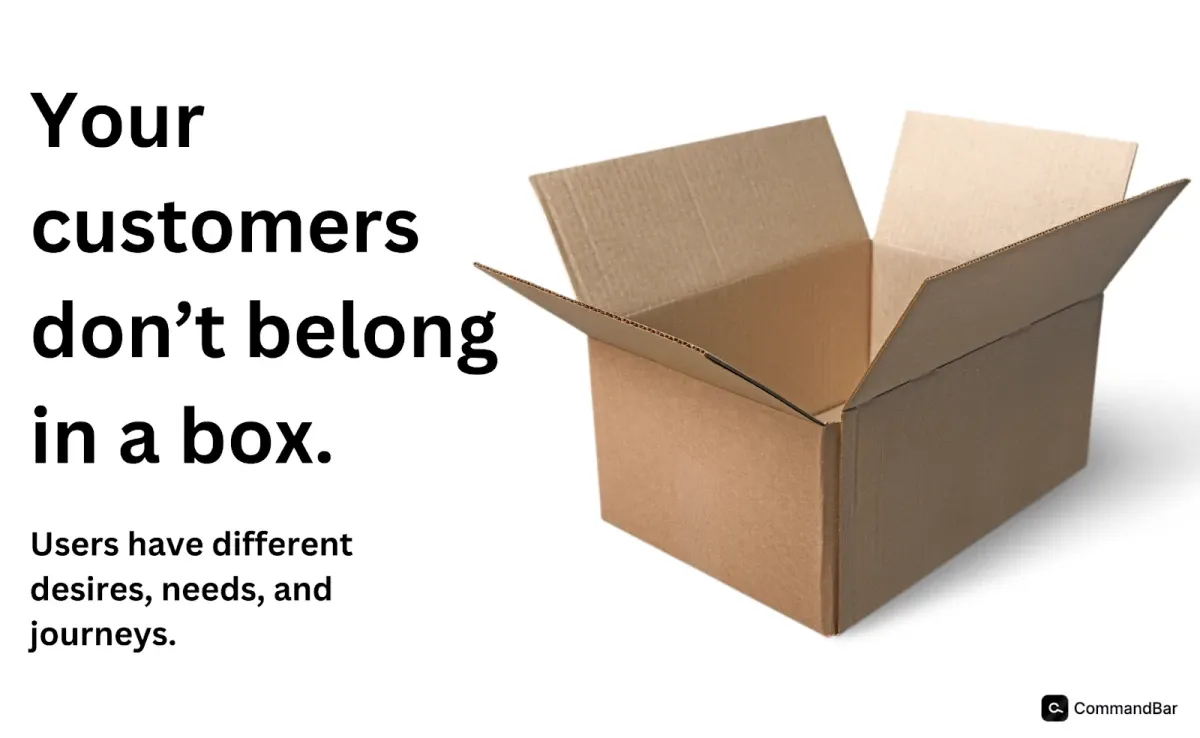
“Great! We have an engagement score,” Fred says, clapping his hands and running to the whiteboard in the conference room. He presses the blue marker on the board. “Now, let’s improve it with popups every two seconds.”
Nancy raises her hand. “That’s a good idea. If we can force the same customer experience, they’ll have no choice but to use our app.”
Fred points to Nancy with approval. “Perfectly said,” he exclaims. He returns to the board and writes a hypothetical higher engagement score. “Then, they can’t help but see the value of our app. We’ll lock ’em in for the long term.” The employees in the room cheer.
OK, back to reality.
Fred and Nancy’s actions sound outrageous, but sadly, too many SaaS companies follow the same trajectory. They annoy customers with popups and force users into the same experience as if they’re the same cutout of a person.
If SaaS companies want to improve user engagement, they should segment their audiences.

Audience segmentation can be based on acquisition channels, user behavior, and other vital needs that can be tracked and analyzed through cohort analysis.
However, asking the user directly about your app is a straightforward, highly effective way to get first-party data.
Don’t be shy—ask the user to improve your customer engagement score
You can ask survey questions on day one with the correct user engagement platform. You can introduce a microsurvey when users sign up for your app and start onboarding.
Ask the user why they want to use your app in the first place. Once you know, you can direct them to a specific use case. In the customer activation experience, they get exactly what they need and immediately reach the aha moment or the time-to-value.
When you have segmented customers based on these onboarding experiences and surveys, you can nurture relationships, keep track of their satisfaction, and use the data to inform customer engagement.
If a particular classified segment is disengaging, you now know what that group values in your app (from the day they signed up), and you can start ahead of the game, saving time and energy.
If you notice users disengaging, you can also send feedback surveys to learn more.
Through feedback, Tracy Davis, the founder and CEO of TRAX Analytics, the restroom monitoring solution for facilities, improved the company’s engagement rating. She states in an exclusive Command AI interview:
“There was a point where one of our key features, meant for real-time analytics, wasn’t hitting the engagement scores we aimed for … we initiated a series of detailed user feedback sessions that highlighted a gap in the intuitiveness of the feature.
“Acting on this, we simplified the interface and added an interactive tutorial spotlighting its value … The engagement score for this feature saw a 45% uplift within three months, which in turn positively impacted our overall platform engagement and customer satisfaction rates.”
Asking, or better yet, listening to customers is the key to building a better experience.
Engaged vs. unengaged users
Once we’ve classified the user groups and correlated them with customer engagement scores, we must know how to approach them based on the customer health score.
Your strategy with highly engaged users should be very different from the strategy you use with unengaged customers.
- Engaged users: Companies can turn these engaged customers into advocates by showing new features that broaden their use case. Businesses can also reach out for testimonials and positive reviews to attract new users.
- Unengaged users: Companies can work at identifying pain points and nudging users toward aha moments.
While both categories have different approaches, they have one core element in common: communication.
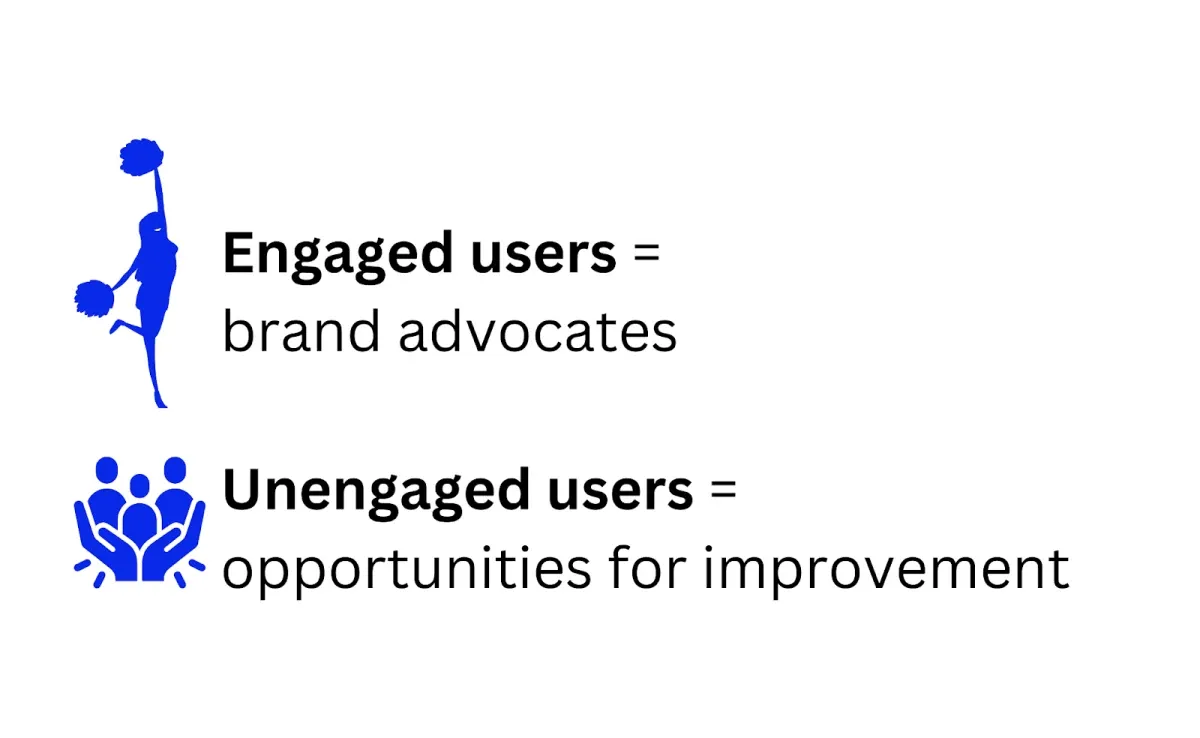
Paul Thomson, the product growth lead at Command AI, states that “Proactive communication and anticipating user needs showcase a dedication to the user’s success, fostering a strong bond that transcends transactional interactions.”
As you build and nurture relationships, you can improve customer engagement with the insight you receive.
Using the engagement score to strategize better UX, user retention, and revenue growth
We know that better data based on segmentation, intuitive onboarding experiences, listening, and communication are essential to improve engagement. Now we must consider turning it into action.
Engagement is all about the customer experience. You’ll chase customers away if your UX, or UX writing, is complicated and uses strange terminology. If customers join rigid onboarding journeys instead of personalized and customized experiences led by their curiosity, then you’ll lose them, too.
Suppose you want to grow revenue, increase user retention, and slash customer churn. In that case, you need a way to collect information and deploy the features necessary to improve the customer experience.
Too often, SaaS companies add several tools to their stack.
Finding the all-in-one right solution for customer engagement score
One tool collects behavioral data.
Another collects surveys.
A third initiates the subscriber-facing features.
It can be a jumble of tools that don’t talk to each other or, at the very least, make your tech stack difficult to use.
One tool, a user assistance platform, that can do it all makes all the difference by spotting improvement areas and helping you implement a plan.
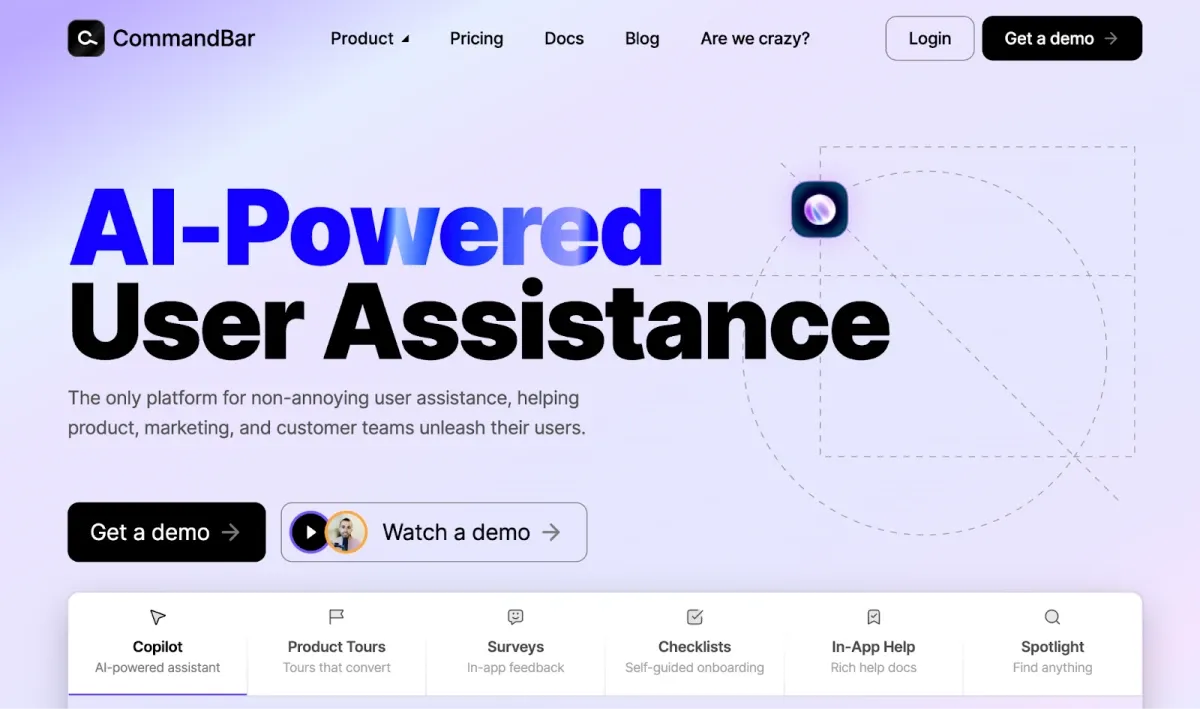
For example, you can send microsurveys with a tool like Command AI to determine why a customer group is disengaging. You can also study user behavior and spot at-risk users.
SaaS platforms can improve the onboarding experience with personalized checklists that give users multiple learning options and take them to their desired use cases. Instead of distracting popups, users get gentle nudges that encourage them to try a new feature or step.
With this strategy, you flip the disengagement narrative on its head and initiate a proactive customer engagement score strategy before it becomes a problem. These intuitive, familiar, and friendly experiences can dramatically change your app experience.
If you want to improve your SaaS engagement score, start with your customers. Spot pain points, solve them, and provide an experience that’s fun, memorable, and natural so that they feel right at home.

















